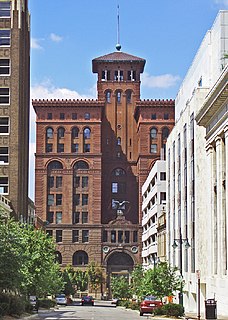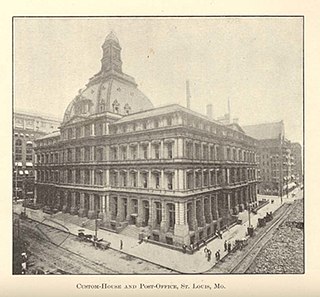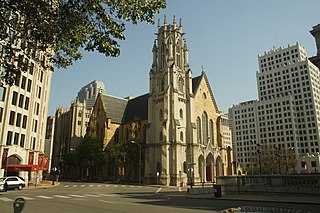
Gateway Arch National Park is an American national park located in St. Louis, Missouri, near the starting point of the Lewis and Clark Expedition.

California is a city in and the county seat of Moniteau County, Missouri, United States. The 2010 census has the population at 4,278. California is the third largest city in the Jefferson City, Missouri Metropolitan Statistical Area, as well as the largest city in Moniteau County.

Eads Bridge is a combined road and railway bridge over the Mississippi River connecting the cities of St. Louis, Missouri and East St. Louis, Illinois. It is located on the St. Louis riverfront between Laclede's Landing, to the north, and the grounds of the Gateway Arch, to the south. The bridge is named for its designer and builder, James Buchanan Eads. Work on the bridge began in 1867, and it was completed in 1874. Eads Bridge was the first bridge across the Mississippi south of the Missouri River. Earlier bridges were located north of the Missouri, where the Mississippi is smaller. None of the earlier bridges survive, which means that Eads Bridge is also the oldest bridge on the river.

The Midland Theatre, known officially for sponsorship purposes as Arvest Bank Theatre at the Midland, is a 3,200-seat theater located in the Power & Light District of Kansas City, Missouri, United States. The National Collegiate Athletic Association under Walter Byers had its headquarters in the building from the 1950s until it moved to 6299 Nall Avenue at Shawnee Mission Parkway in Mission, Kansas in 1971. The theatre was originally known as the Loew's Midland Theatre until 1961. Over the years, the theatre has been known by various names including: Saxon Theatre, Midland Stadium, Midland 1-2-3 Theatre, Midland Theatre and The Midland by AMC.

St. Louis Union Station is a National Historic Landmark train station in St. Louis, Missouri. At its 1894 opening, the station was the largest in the world that had tracks and passenger service areas all on one level. Traffic peaked at 100,000 people a day the 1940s. The last Amtrak passenger train left the station in 1978.

The Missouri Theatre, is a concert and entertainment venue in downtown Columbia, Missouri, occupying most of a city block between 9th street between Locust and Elm Streets. It was designed after the Opéra Garnier by the Boller Brothers, built in 1928, and is on the National Register of Historic Places. It is Columbia's only surviving pre-Depression movie palace and vaudeville stage. In 2011, the University of Missouri began a three-year lease of the facility. The Missouri Theatre is the resident home of the Missouri Symphony Orchestra, and is also frequently used by University of Missouri and civic groups. As of July 1, 2014, The University of Missouri took over ownership of the Missouri Theatre. It is one of the main performance venues for the University of Missouri School of Music.

The Old St. Louis County Courthouse was built as a combination federal and state courthouse in St. Louis, Missouri. Missouri's tallest habitable building from 1864 to 1894, it is now part of Gateway Arch National Park and operated by the National Park Service for historical exhibits and events.

The New York Life Building is a 12-story, 54.86 m (180.0 ft) high-rise in the Library District of downtown Kansas City, Missouri. The brick and brownstone tower, which was completed in 1890, generally is regarded as Kansas City's first skyscraper and was the first building in the city equipped with elevators. It was commissioned by the New York Life Insurance Company, which also used the same design for the Omaha National Bank Building in Omaha that was completed in 1889. Several buildings around the world share its name. A centerpiece of the Library District and Baltimore Avenue Historic District, the building is located amid historic structures such as the Kansas City Club and the Central Library.

Ste. Genevieve Historic District is a historic district encompassing much of the built environment of Ste. Genevieve, Missouri. The city was in the late 18th century the capital of Spanish Louisiana, and, at its original location a few miles south, capital of French Louisiana as well. A large area of the city, including fields along the Mississippi River, is a National Historic Landmark District designated in 1960, for its historically French architecture and land-use patterns, while a smaller area, encompassing the parts of the city historically important between about 1790 and 1950, was named separately to the National Register of Historic Places in 2002.

The U.S. Custom House and Post Office is a court house at 815 Olive Street in downtown St. Louis, Missouri.

Christ Church Cathedral is the Episcopal cathedral for the Diocese of Missouri. It is located at 1210 Locust Street in St. Louis, Missouri. The Dean of the Cathedral is the Very Reverend Kathie Adams-Shepherd. Adams-Shepherd is also the first female dean of this cathedral. Built during 1859–67, it is one of the few well-preserved surviving works of Leopold Eidlitz, a leading mid-19th-century American architect, and was designated a national historic landmark in 1994 for its architecture.

Watkins Mill in Lawson, Missouri, is a preserved woolen mill dating to the mid-19th century. The mill is protected as Watkins Woolen Mill State Historic Site, which preserve its machinery and business records in addition to the building itself. It was designated a National Historic Landmark and added to the National Register of Historic Places in 1966 in recognition for its remarkable state of preservation. The historic site is the centerpiece of Watkins Mill State Park, which is managed by the Missouri Department of Natural Resources.

The Grand Riviera Theater was a movie palace theater located at 9222 Grand River Avenue in western Detroit, Michigan. It took its name from Grand River Avenue. It was designated a Michigan State Historic Site in 1980, and listed on the National Register of Historic Places in 1982, but was subsequently demolished in June, 1996. The building was removed from the National Register in 2020.

The Standard Theatre, now known as the Folly Theater and also known as the Century Theater and Shubert's Missouri, is a former vaudeville hall in downtown Kansas City, Missouri. Built in 1900, it was designed by Kansas City architect Louis S. Curtiss. The theater was associated with the adjoining Edward Hotel, which was also designed by Curtiss; the hotel was demolished in 1965.

The Kahl Building is an historic building located in Downtown Davenport, Iowa, United States. It was listed on the National Register of Historic Places in 1983. In 2020 it was included as a contributing property in the Davenport Downtown Commercial Historic District. The building also includes the Capitol Theatre.

Mineral Hall in Kansas City, Missouri is a historic building constructed in 1903. An elaborate example of Prairie School architecture by Louis Singleton Curtiss, it originally served as a residence.

The Moolah Temple, formally the Moolah Temple of the Mystic Shrine, is a historic building located at 3821 Lindell, in St. Louis, Missouri. It was built in 1912 for use as a meeting place, and is "a brick and tile building in the Moorish style.
Helfensteller, Hirsch & Watson was an early twentieth-century American architectural firm from St. Louis, Missouri. It succeeded Hirsch and Helfensteller which had been founded in 1903. The firm's partners included Ernest Helfensteller, William Albert Hirsch and Jesse N. Watson. The firm quickly gained prominence with its 1912 design of the Moolah Temple in St. Louis.

The Sylvan Theater Historic District, also known as Greenwood Park Outdoor Theater, is located in Des Moines, Iowa, United States. It has been listed on the National Register of Historic Places since 1995.

Armour Theatre Building is a historic theatre building located at North Kansas City, Missouri. It was designed by the architectural firm Keene & Simpson and built in 1928. It is a two-story, polychromatic brick building with Spanish Eclectic style design elements. It features a Mission tile roof, arched fenestration and decorative tiles, and glazed terra cotta detailing. The building houses the theater, community rooms, and offices.

























